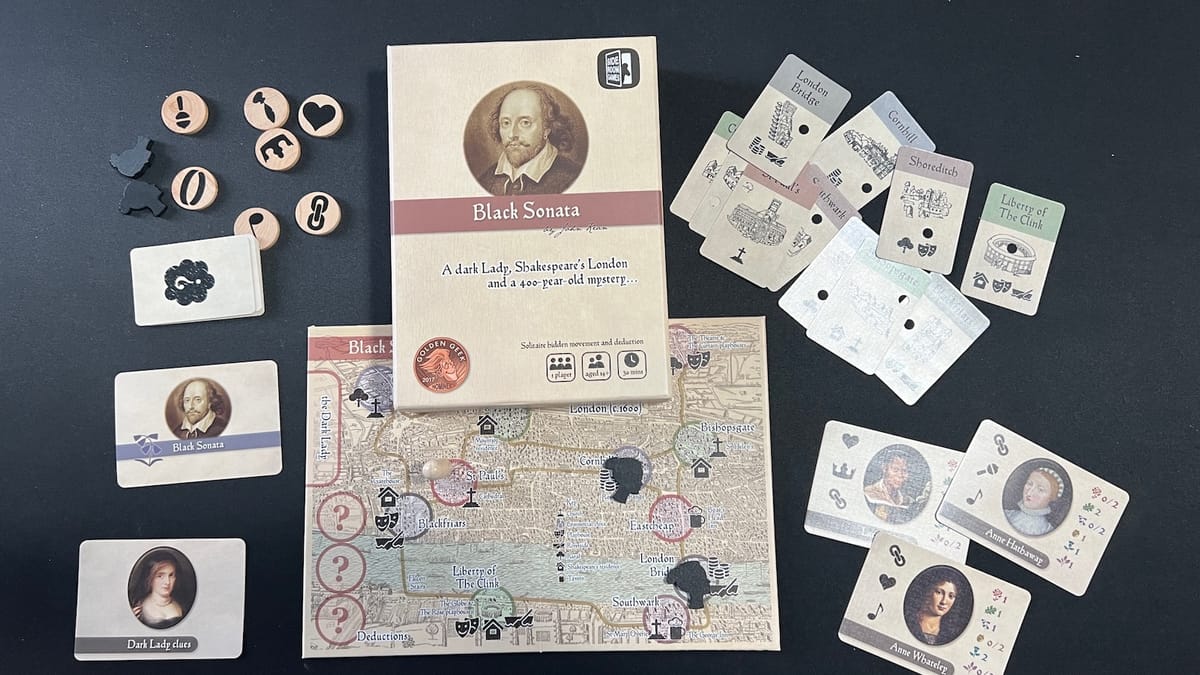
Many games in the tabletop space have solo modes. Oftentimes they adapt the rules to add in a dummy player, have players play in an alternate way, sometimes players are trying to beat a top score, and sometimes they are given a list of challenges. Usually these modes are added as an afterthought and are not always fleshed out compared to their multiplayer companions. Then there are the games that are created specifically for one player. These games are even less common, but offer players an opportunity to go on an adventure designed specifically for them. With Black Sonata, players are treated with an adventure through an Elizabethan era Shakespeare adventure.
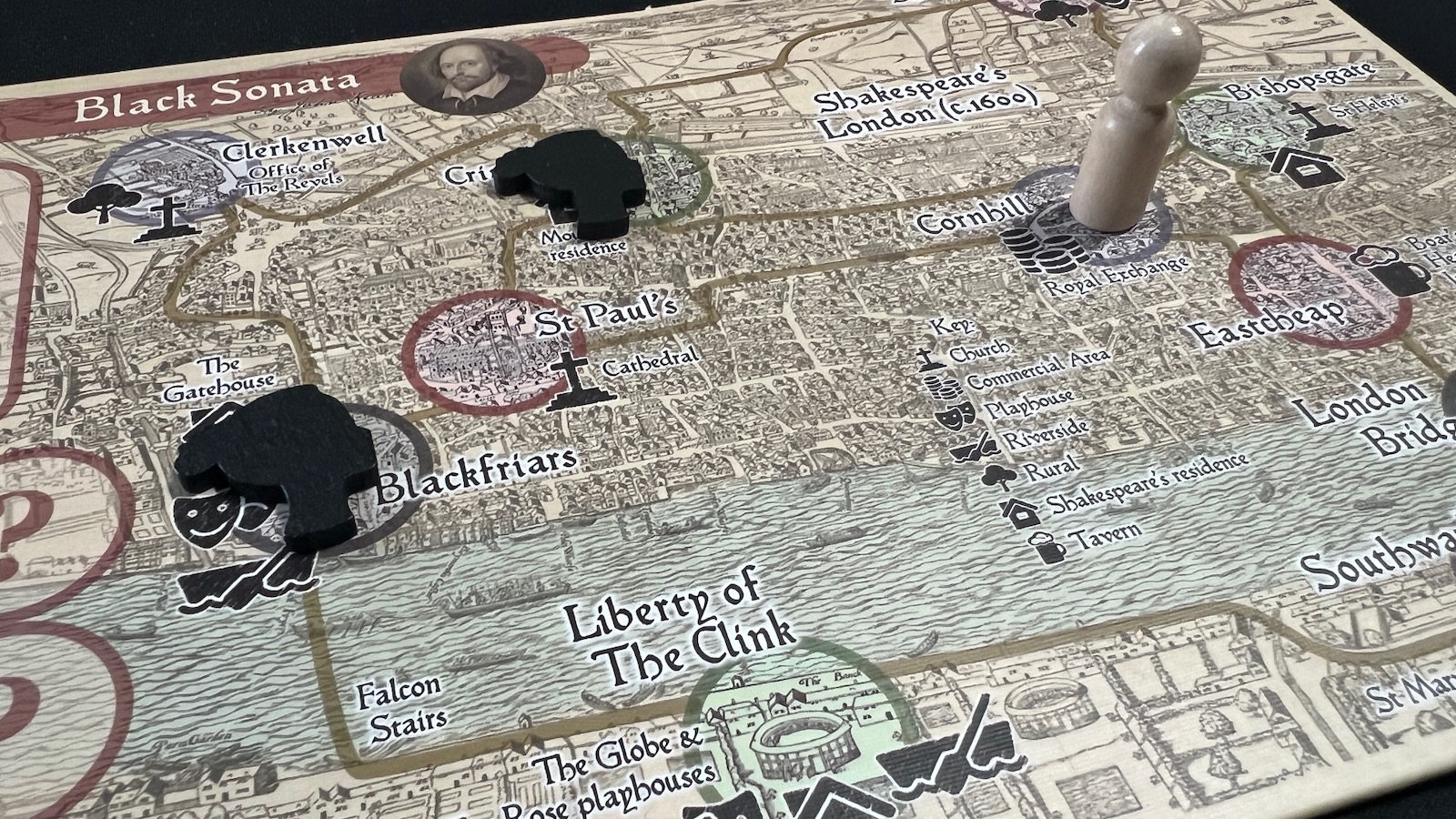
Game board with player pawn and markers denoting where the Dark Lady might be
Black Sonata, created and illustrated by designer John Kean, has a solo player pursuing the mysterious Dark Lady mentioned in a number of William Shakespeare’s sonnets. Players must collect clues along the way to deduce the location of the lady and figure out what three attributes the lady possesses to unmask the Dark Lady’s true identity before time runs out.
The set-up of the game has a few steps, but helps make the game replayable. Players start by selecting a starting location, placing their pawn on the board, and taking a matching location card. Next, players draw a random clue card and place it face down below the main board. This clue card has one of six flower symbols printed on the back and represents one of the twelve possible identities of the Dark Lady. Players will take the clue card with the matching flower symbol and place it behind the chosen lady card and will then stack remaining location cards on top. The rest of the clue cards are placed face up in a stack underneath a clue mask card. Certain clue cards can be removed from the stack to adjust the difficulty of the game.
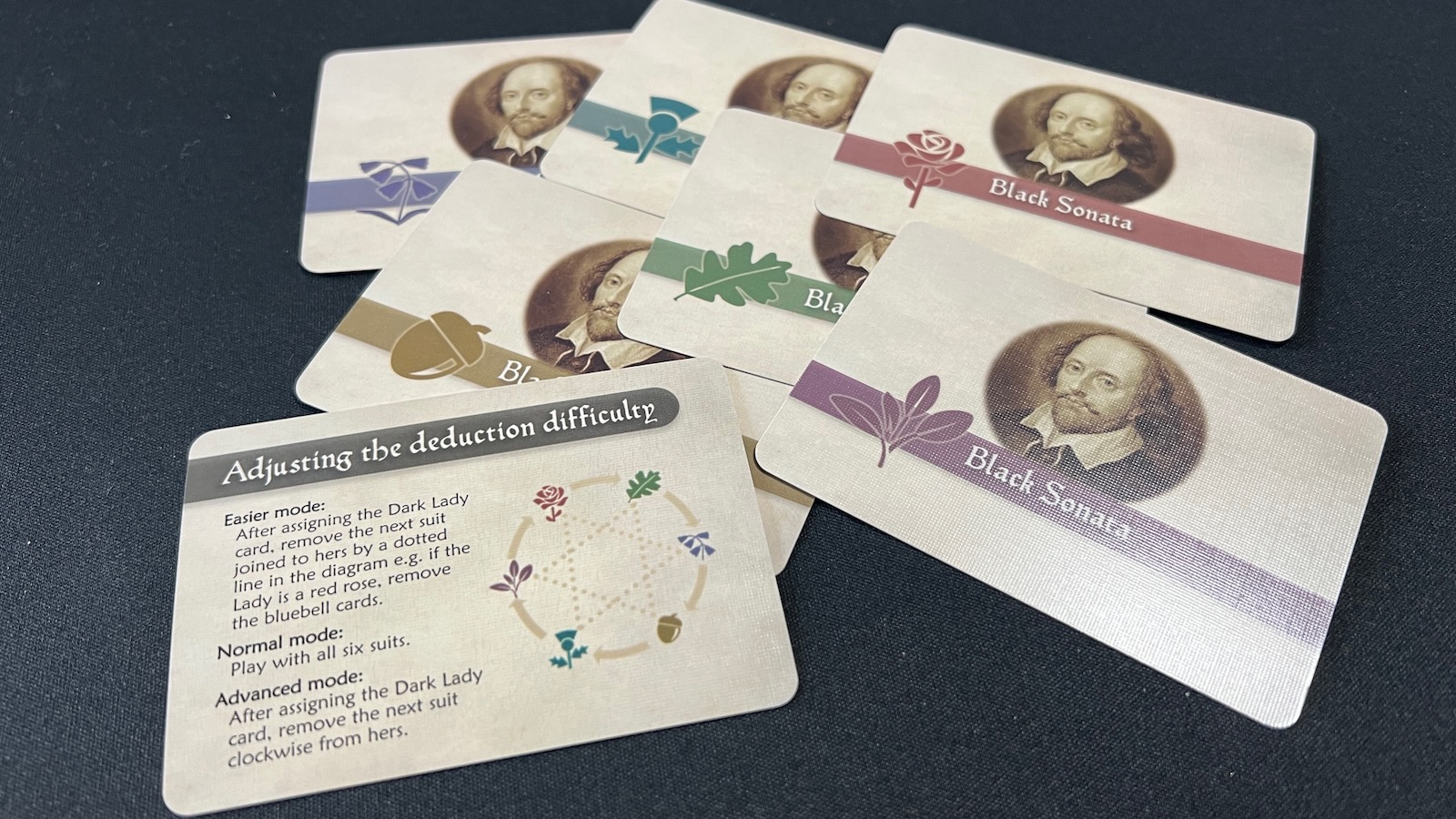
Dark Lady cards and instructions for adjusting the difficulty.
The next stage of the set-up, the creation of the stealth deck, is where most of the variation and leveling takes place. In the game, the player will use a deck of cards to determine the hidden movement of the Dark Lady around the board. To set up the deck, the player takes one card from the movement deck and selects one of eight letters on the top or the bottom of the card. Letters on the top of the card in the purple row indicate that the Dark Lady will move every turn, but selecting a letter from the bottom row raises the difficulty because the Dark Lady will sometimes stay put, making her harder to track. After a letter is chosen, the player will put the deck in alphabetical order, cut the deck, and place a round tracker card on the bottom of the deck.
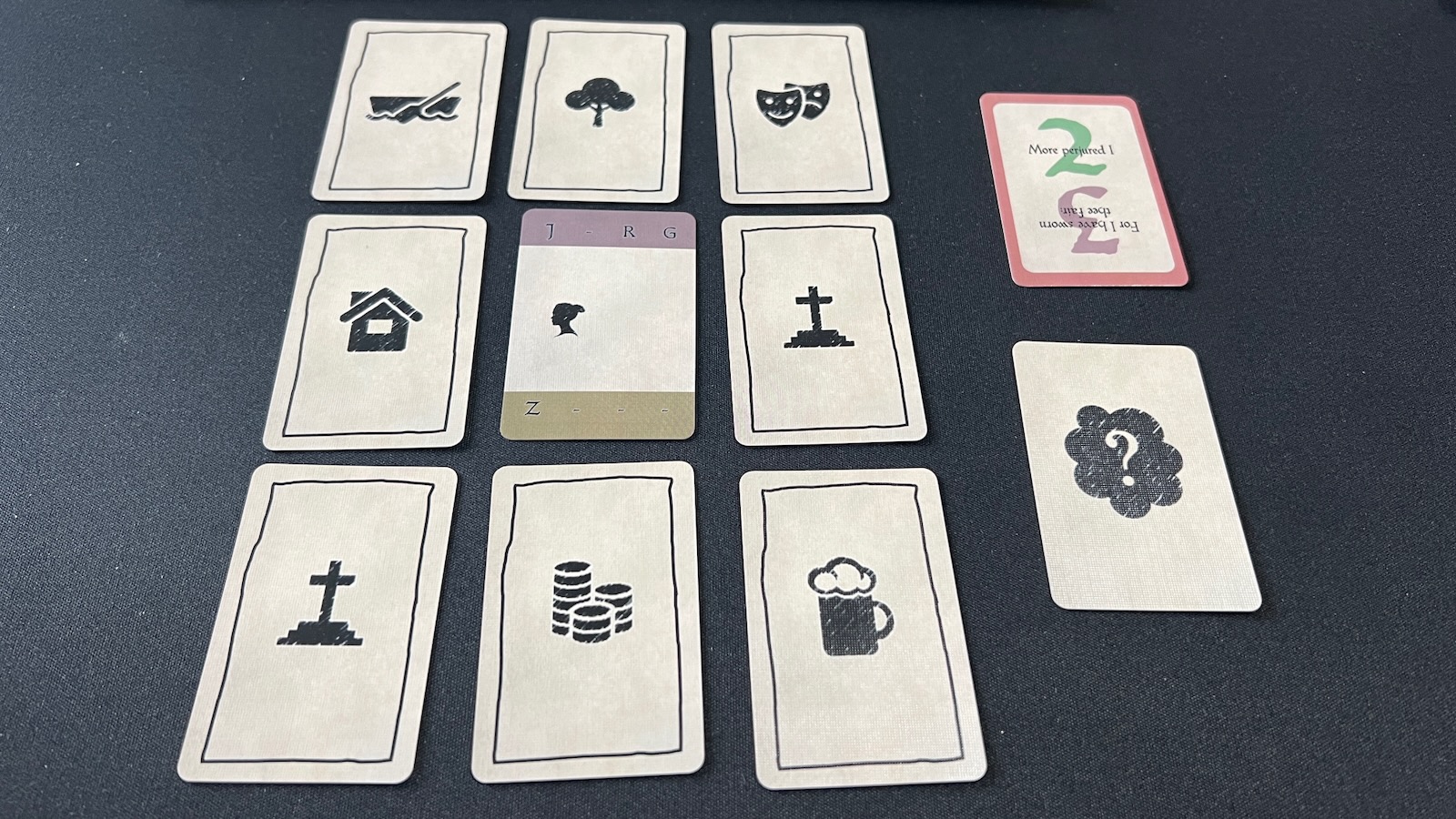
Symbols featured on the back of the stealth deck and an example of the opposite side used in set up.
A player turn is fairly simple and happens in two phases. In phase one, the player will take the top card of the stealth deck and move it to the bottom. The new top card gives the player a clue to where the Dark Lady has moved by showing a symbol associated with various locations on the board. The player can use markers to determine the locations she might be. On a player turn, they can take one of a variety of actions.
- Move your pawn to an adjacent location.
- When moving to a new location, they will take the associated location card and add it to their supply.
- If a player can visit all locations at least once, then they are allowed to look at the clue card underneath the stack of location cards.
- Search your current location
- If a player thinks the lady is at their location, they will take a fog card and replace the current top card of the stealth deck (without revealing the next clue)
- The player will then take the replaced stealth card and place it face down on the current location card and flip the two cards over.
- If a face is revealed in the hole on the location card, you have found the Dark Lady and the player takes a clue card from the stack.
- After this step, the lady flees. Players will take a number of stealth cards, without looking, from the top of the stealth deck equal to the number clue cards they have and move them to the bottom of the deck.
- During setup, a countdown card was put at the end of the stealth deck. When players reach this card, they will rotate it down one marker and start the deck over again.
- Use a fog card action
- Fog cards replace stealth cards that have been used to search for the Dark Lady and these cards do not have a matching symbol to any board locations.
- Each fog card has an effect that could be beneficial or detrimental to the search for the Dark Lady.
- If they choose to activate, players will replace the fog card with a new one and then carry out the action on the back of the card.
- If the fog deck ever runs out, then the game is lost.
- Pass without taking an action
- This can be good if the Dark Lady may be in the vicinity with a chance to move to the player’s location on the next turn
As players collect clue cards, they will use them to deduce the traits of the Dark Lady. Each card has three trait symbols and a key, telling the players how many of these trait symbols match the characteristics of the face down Dark Lady card. Players will need to collect multiple clue cards to narrow down the three symbols unique to the face down Dark Lady. Players are provided with wooden tokens to help them narrow down the three characteristics and a location on the board for their final deduction.

Location cards and an example of Dark Lady traits.
Play will continue until one of a few conditions is met. If a player thinks they have all three aspects of the Dark Lady figured they can find and confront the Dark Lady. They will reveal the face down card and compare the traits on the card with their three tokens on the board. If they match, the player wins. If they don’t, they lose. Other conditions causing a loss for the player include running out of cards in the fog deck and moving through the stealth deck a certain number of times, depending on the difficulty. In the event of a win, players will see how many cards they have left in the stealth deck before they reach the countdown card. They will then add that total to the number of cards in the stealth deck multiplied by the number on the countdown card to get a final score. This final score is compared to a list of titles and players can judge themselves accordingly.
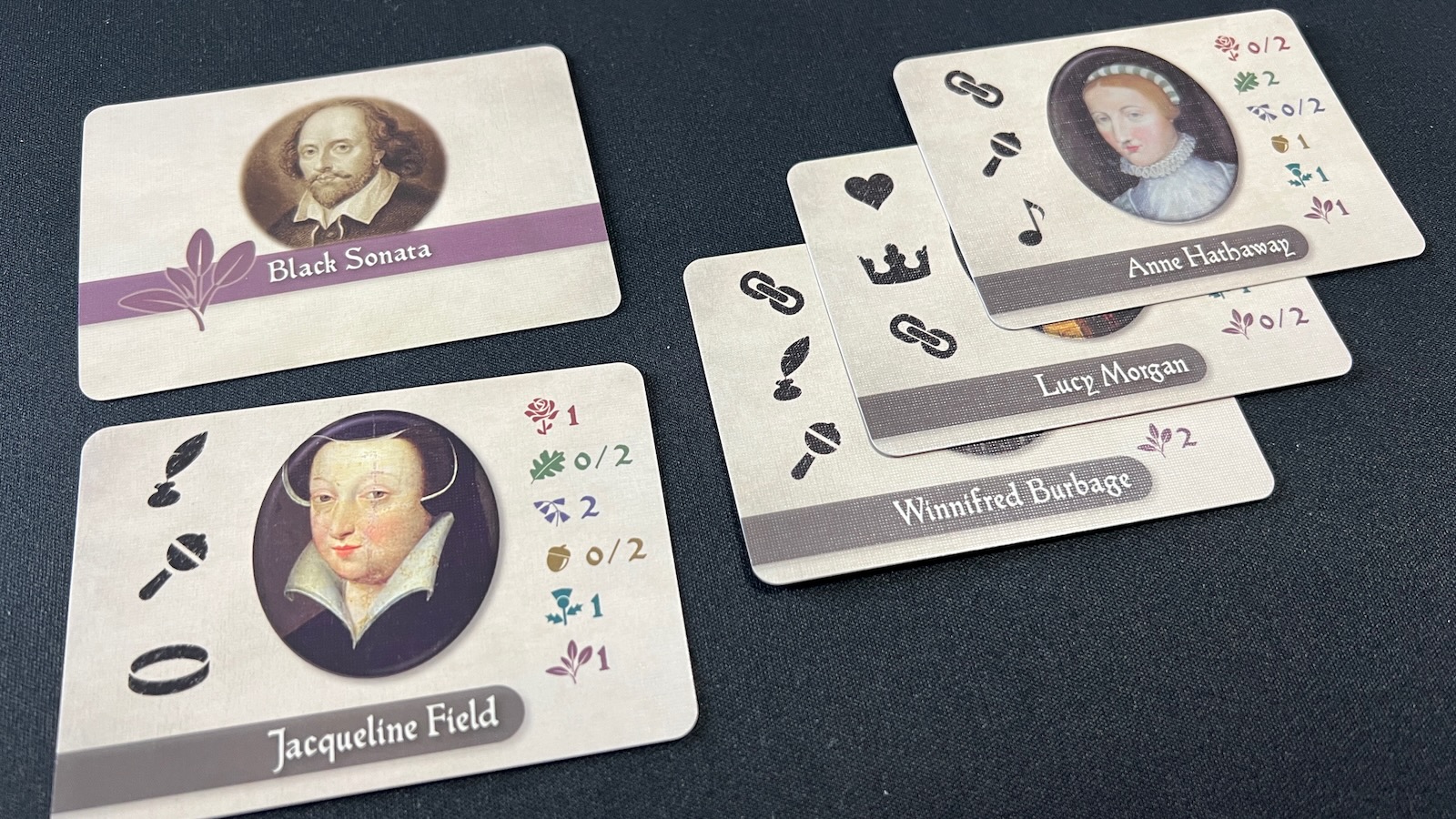
Dark Lady cards and clues to how to determine the Dark Lady traits.
The production of this game is simple and effective. The board is not overly complicated and features a stylized map of London with the game locations printed on top. The cards are of good quality and easy to read. While a few images of the Black Ladies use actual renderings of the subject, many did not have images, so other portrayals of Elizabethan era women were used, so as not to detract from the theme. The trait and Dark Lady markers are made of wood, with the Dark Lady markers cut into the same pattern featured on the stealth cards. The developer provided tuck boxes for the different sized cards and all components fit nicely into the simple organizer.
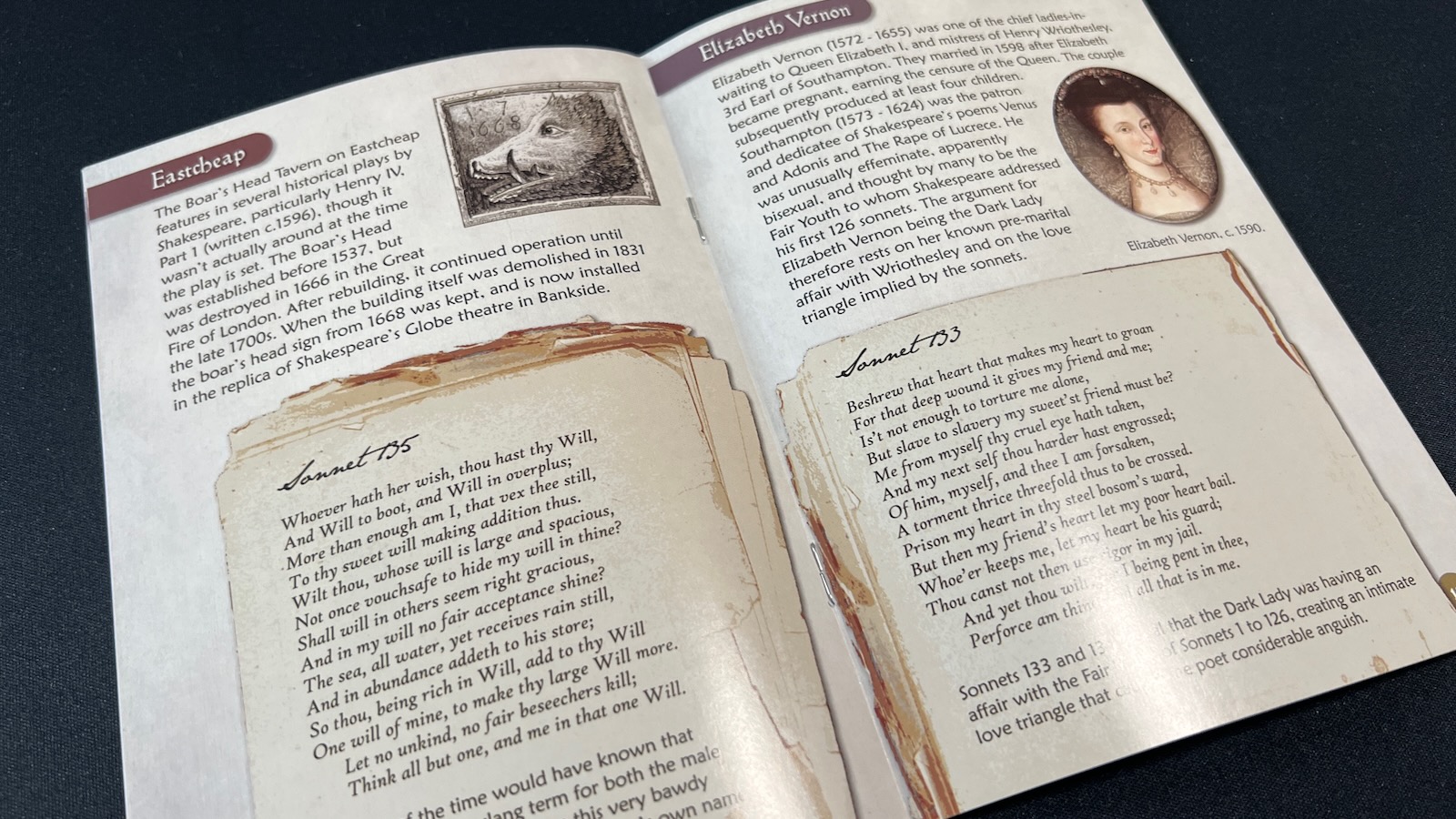
Another pleasant addition to the game is the accompanying booklet titled “Shakespeare’s Long and the Dark Lady of the Shadows.” This booklet helps set the context of the game and includes descriptions of the board locations, text of some of the sonnets that reference the Dark Lady, dossiers on the ladies featured in the game. As a former history teacher and owner of the complete works of Shakespeare, I found this information a fantastic accompaniment to my immersion into the mechanics of the game.
The gameplay for this one is what I like to call a weeknight snack. It’s as complicated as I would like to make it depending on the kind of day I’ve had, and even on the hardest difficulty, it doesn’t feel like I’ve just run a marathon to get through the game.
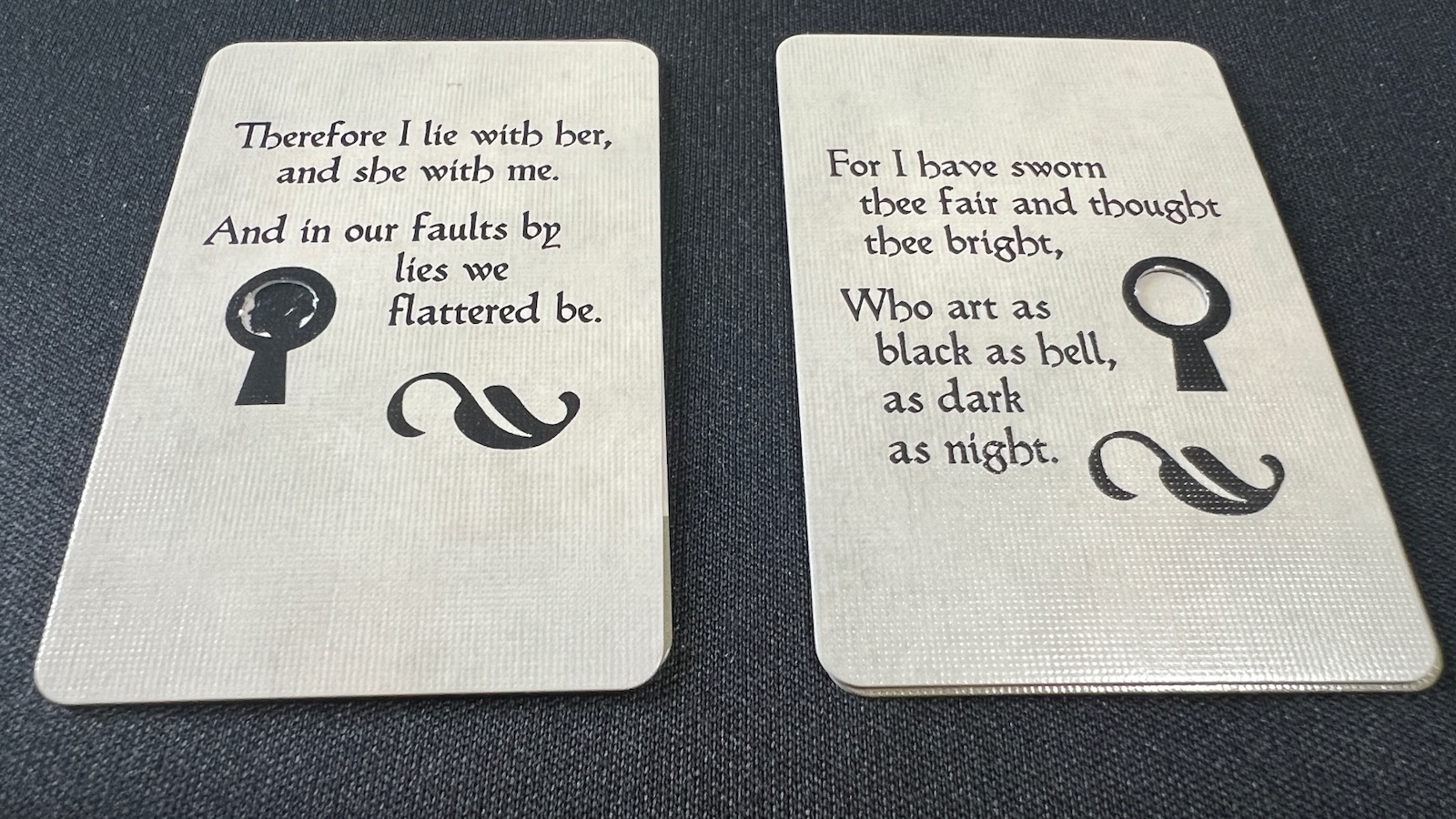
Confront the Dark Lady and hope she shows up in the magnifying glass.
The stealth deck mechanic is brilliant. To be able to use one deck of cards in a variety of different combinations, allows for players to adjust the difficulty level and adds to replayability. While players can use the cards 16 different ways from the printed sequences on the cards, the rule book also provides another 40 different sequences with various difficulty levels. The stealth deck also contributes to the hidden movement aspect of the game. Players have to use their intuition to try and guess the movements of the Dark Lady around London to gain more clue cards, but have to be careful not to guess the wrong location causing the stealth deck to deplete quicker. As the game progresses, these decisions become very tight. The use of the clue cards and the location cards as a decoder element is also a lot of fun.

Fog cards and help or hinder your search for the Dark Lady.
The other brilliant aspect of the game are the Dark Lady clue cards. Players must use the clues given on multiple cards to deduce the three traits of their chosen Dark Lady. The more clue cards the player has, ramps up the speed at which the players reach the end of the game, so figuring out the clues quickly is imperative for a high score.
My only detractors from the game came in the initial set-up and the end game. The initial set-up can be a chore for some players. Trying to set up a clue deck, and a location deck, and a tricky stealth deck was slightly off-putting my first playthrough. However, once you have set the game up and played a couple times, the process becomes much much easier. The other downside for me is the solo-only trap of comparing your score to a chart. There are adjustments that are made for changing the difficulty of the game, but getting the same old “golden lad” or “fair youth” can lose its luster. This is a small detractor, however, because the joy of solving the puzzle is quite enough for me.
Black Sonata
Excellent
Black Sonata is a fantastic entry into the solo game space and I have enjoyed my time with the game. The game is light enough to get to the table after a long day and provides a runtime that allows for a few rounds in an evening. The mechanics of the game are top notch and while the theme may not be everybody’s cup of tea, the gameplay is where Black Sonata shines.
Pros
- Replayability options are high
- Immersive theming elements
- A scalable puzzle that only takes 30-45 minutes to complete
Cons
- Learning the set-up for new players
- The solo mode compare your score to the chart trap
